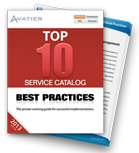There are many paths organizations could take to achieve optimal IT Service Management (ITSM). While the necessity of a refined process for ITSM may not be apparent immediately, its essential nature in handling Identity and Access Management (IAM) issues becomes glaringly apparent as the help desk becomes more saturated with requests.
But as business has progressed over the past decade, many believe that IT Service Management has not. Stephen Mann of Forrester Research recently compared tracks from an ITSM conference in 2009 to a parallel one coming up this year and noted many similarities. This prompted him to comment, “Unfortunately we still seem to be stuck on the basics.”
Being “stuck” and approaching modern ITSM business issues with the “basics” is about as far removed from optimal business practice as an organization can get. Add to that the fact that many companies continue to rely upon outside sources to install and maintain IT Service Management solutions and the entire process becomes a long and winding road marked with potholes.
A much shorter and straighter path is to take an internal approach to IT Service Management that features automated self-service group management and self-service IAM.
The following features should come “standard” on this “cruise control” version of ITSM:
- User Account Provisioning: The process of IT service management begins with provisioning, so any road to ITSM should begin with automated user provisioning based on approved role definitions. This establishes a system where user accounts are created as new employees are added to the corporate human resources system and ensures fast, efficient user provisioning and compliance with regulatory security requirements.
- Password Management: Hackers look for the easiest targets. Organizations should therefore employ an automated password management solution that creates a single strong password that can be used across all applications and platforms, but which combines strong password policies with secure, self-service password reset and cross platform synchronization. This ensures organizations meet their security needs while improving efficiency and productivity.
- Self-Service Group Management: Self-service group management software lowers cyber security risks associated with group membership management. It protects resources, stops unwarranted group growth and prevents endless processing by empowering trusted business users with self-service group provisioning.
- Password Synchronization: Allowing business users to reset passwords in active directory without making a helpdesk password reset request can increase efficiency exponentially. Imagine the efficiency increases realized when that single Active Directory password change is then sychronized across all system types thus eliminating the majority of all password helpdesk requests.
- Identity Intelligence: Analyzing identity and access management, user provisioning and access certification information reveals cyber security risks security and compliance management information that in the past generally remained hidden or was simply unavailable without automation.
Watch the Avatier Lifecycle Management product introduction video to learn more about the need for IT Risk Management Software.
 Get the Free Top 10 ITIL Service Catalog Best Practices Workbook
Get the Free Top 10 ITIL Service Catalog Best Practices Workbook
A successul Service Catalog roll-out requires careful planning, strategic decision-making and innovation. Before you start your ITIL service catalog initiative, learn from industry experts. Sidestep challenges that derail projects. Get our Top 10 Service Catalog Best Practices — The proven guide for successful implementations.




